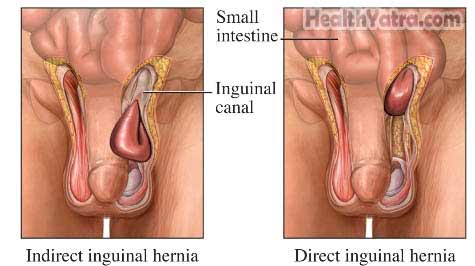تعريف
This operation treats a hernia. A hernia forms when your abdominal wall weakens, bulges, or tears. This causes the inner lining of the abdomen to protrude and form a sac outside of the abdomen. Abdominal contents, such as the small intestine, can move into and get stuck in this sac.
Hernias can occur in different areas, like:
- Groin (called inguinal hernia)—the most common site
- Navel
- The site of a surgical incision
- The upper-middle abdomen
- Between the abdomen and thigh (called femoral hernia)
- Where the esophagus joins the stomach (called hiatal hernia)

أسباب هذا الإجراء
This is done to repair the hernia. You will have surgery to prevent the hernia from becoming “strangulated” (pinched so that the blood supply is cut off). If strangulation happens, you will need immediate surgery. Without surgery, the hernia will not heal. The pain and size of the hernia usually increases over time.
المضاعفات المحتملة
Complications are rare, but no procedure is completely free of risk. If you are planning to have a hernia repair, your سيقوم الطبيب بمراجعة القائمة من المضاعفات المحتملة، والتي قد تشمل:
- Damage to neighboring organs or structures (such as, intestine or bladder)
- العدوى
- نزيف
- تندب
- Pneumonia and other risks of general anesthesia
تشمل العوامل التي قد تزيد من خطر حدوث مضاعفات ما يلي:
- Having neurological, heart, or lung conditions
- العمر: أكبر من 70 سنة
- السمنة
- التدخين
- Active infection
ما يمكن توقعه
قبل الإجراء
قد يقوم طبيبك بما يلي:
- اختبار بدني
- تحاليل الدم
- اختبارات البول
- Electrocardiogram (ECG)—a test that records the heart’s activity by measuring electrical currents through the heart muscle
- التحدث مع طبيبك عن الأدوية الخاصة بك. قد يطلب منك التوقف عن تناول بعض الأدوية تصل إلى أسبوع واحد قبل العملية مثل:
- الأسبرين أو غيره من العقاقير المضادة للالتهابات
- سيولة الدم, مثل كلوبيدوجريل (بلافيكس) أو الوارفارين (الكومادين)
On the days before and the day of your procedure, your doctor may recommend that you:
- اتبع حمية غذائية خاصة.
- Take antibiotic medicine.
- Shower the night before, using antibacterial soap.
- Arrange for someone to drive you home and to help you at home.
- في الليلة السابقة ، تناول وجبة خفيفة. لا تأكل أو تشرب أي شيء بعد منتصف الليل.
- Wear comfortable clothing.
التخدير
Depending on the type of repair, you may receive:
- Local anesthesia—the area will be numbed
- General anesthesia—used most often, you will be asleep
الوصف الداخلي
Conventional Hernia Repair
An incision is made over the hernia site. The hernia will be moved back into the abdominal cavity, or the sac may be removed. The muscles around the hernia are sewn together. This will repair the hole or weakness. If the hernia is large or in the groin, a piece of mesh will be inserted. If mesh is used, the muscle is not sewn together.
Laparoscopic Hernia Repair
A laparoscope is a thin tube-shaped object with a camera on the end. It will be inserted through a small incision. The doctor will be able to see the hernia on a nearby TV. Small instruments will be inserted through other small incisions. These tools will be used to complete the repair.
After the procedure, the incisions will be closed with stitches or staples. A sterile dressing will be applied.
مباشرة بعد الإجراء
You will be taken to a recovery area. There you will receive fluids and pain medicines through an IV. If there are no problems, you will be moved to a hospital room to recover.
كم من الوقت سيستغرق ؟
Less than two hours
هل ستسبب الالم؟
Anesthesia prevents pain during surgery. You may feel pain during recovery, but taking pain medicine will help.
رعاية ما بعد العملية
Be sure to follow your doctor’s instructions. When you return home, do the following to help ensure a smooth recovery:
- In most cases, you can return to your normal diet after a few days.
- During the first few days, slowly return to your normal routine.
- تناول مسكنات الألم حسب الحاجة.
- Ask your doctor about when you can do certain activities (such as driving, sexual activity). You may need to wait 1-2 weeks.
- اسأل طبيبك حول, عندما هي آمنة للاستحمام, السباحة, أو نقع في الماء.
- Avoid excess strain (such as vigorous يمارس and lifting) for 6-8 weeks.
The recovery time will be shorter for laparoscopic surgery.
There is some risk that the hernia could return. To reduce your risk:
- الحفاظ على أ وزن صحي.
- Strengthen your abdominal muscles.
- Treat chronic constipation, allergies, or chronic cough.
- Eat a high-fiber diet.
استدعاء الطبيب
بعد وصوله الى المنزل ، اتصل بطبيبك إذا كان أي من الحالات التالية:
- علامات الإصابة, بما في ذلك حمى وقشعريرة
- احمرار أو تورم أو ألم متزايد أو نزيف شديد أو أي إفرازات من موقع الشق
- الغثيان و / أو القيء الذي لا يمكنك السيطرة عليه بالأدوية التي أعطيت لك بعد الجراحة ، أو التي تستمر لأكثر من يومين بعد الخروج من المستشفى
- ألم لا يمكنك السيطرة عليه بالأدوية التي أعطيت لك
- ألم أو حرقة أو إلحاح أو كثرة التبول أو نزيف مستمر في البول
- Excessive tenderness or swelling
- سعال أو ضيق في التنفس أو ألم في الصدر
في حالة الطوارئ ، اتصل على المساعدة الطبية على الفور.
